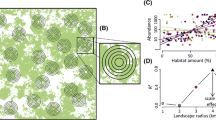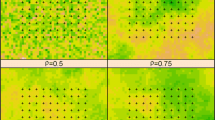Abstract
Purpose of Review
We review recent methodological advancements in estimation of distance-dependent landscape effects on terrestrial species. These methods address key theoretical elements from landscape and metapopulation ecology that were ignored in previous approaches. Models that treat landscapes as circles within which all land features are equally important to a focal population ignore distant-dependent population processes, such as dispersal, resource selection, and social interactions. Realistic models that estimate variation in landscape-scale effects over space and time are necessary to understand the complex processes that influence population dynamics.
Recent Findings
The addition of kernel smoothers to generalized linear models has potential to increase the biological realism of landscape-species models. These models include estimation of parameters that dictate the relationship between distance and importance of landscape features to focal populations. There are examples of implementing these models in both maximum likelihood and Bayesian frameworks, as well as examples using model selection to determine appropriate smoothing kernel shape. One key limitation of these models is computational effort, although we provide some guidance for reducing model runtime.
Summary
Models allowing for inference on explicit ecological processes are critical to advancing knowledge of the basic landscape ecology of species and will benefit efforts to prioritize conservation and evaluate species recovery efforts. We describe how distance-dependent landscape-scale effect models can be used for these purposes in a variety of scenarios. We conclude by proposing a process-based, spatio-temporal framework for understanding the mechanisms behind the spatial scale at which landscapes influence species.

Similar content being viewed by others
References
Papers of particular interest, published recently, have been highlighted as: • Of importance •• Of major importance
Forman RTT, Godron M. Patches and structural components for a landscape ecology. Bioscience. 1981;31:733–40.
Wiens JA. Spatial scaling in ecology. Funct Ecol. 1989;3:385–97.
Forman RTT. Some general principles of landscape and regional ecology. Landsc Ecol. 1995;10:133–42.
Turner MG. Landscape ecology: what is the state of the science? Annu Rev Ecol Evol Syst. 2005;36:319–44.
Wilson MC, Chen XY, Corlett RT, Didham RK, Ding P, Holt RD, et al. Habitat fragmentation and biodiversity conservation: key findings and future challenges. Landsc Ecol. 2016;31:219–27.
Levin SA. The problem of pattern and scale in ecology. Ecology. 1992;73:1943–67.
Jackson HB, Fahrig L. Are ecologists conducting research at the optimal scale? Glob Ecol Biogeogr. 2015;24:52–63.
Hanski I. Metapopulation ecology. New York: Oxford University Press; 1999.
Miguet P, Jackson H, Jackson N, Martin A, Fahrig L. What determines the spatial extent of landscape effects on species? Landsc Ecol. 2016;31:1177–94.
• Stuber EF, Fontaine JJ. How characteristic is the species characteristic selection scale? Glob Ecol Biogeogr. 2019;28:1839–54. Present evidence that there is variation within and among species regarding the spatial scale dictating population-landscape relationships, and they indicate that it is likely there are multiple spatial scales of selection for any one species.
Forman RTT. An ecology of the landscape. Bioscience. 1983;33:535.
Troll C. The geographic landscape and its investigation. In: Weins JA, Moss MR, Turner MG, Mladenoff DJ, editors. Foundation papers in landscape ecology. 2006. New York: Columbia University Press; 1950.
Lack D. Ecological features of the bird faunas of British small islands. J Anim Ecol. 1942;11:9–36.
MacArthur RH, Wilson EO. An equilibrium theory of insular zoogeography. Evolution (N Y). 1963;17:373–87.
Whittaker RH. Vegetation of the Great Smoky Mountains. Ecol Monogr. 1956;26:1–80.
Mcgarigal K, Cushman SA, Ene E. FRAGSTATS v4: spatial pattern analysis program for categorial and continuous maps. Amherst: Comput Softw Progr Prod by authors Univ Massachusetts; 2012.
Wiens JA. Population responses to patchy environments. Annu Rev Ecol Syst. 1976;7:81–120.
Carr LW, Fahrig L. Effect of road traffic on two amphibian species of differing vagility. Conserv Biol. 2001;15:1071–8.
Holland JD, Fahrig L, Cappuccino N. Body size affects the spatial scale of habitat–beetle interactions. Oikos. 2005;110:101–8.
Fahrig L, Baudry J, Brotons L, Burel FG, Crist TO, Fuller RJ, et al. Functional landscape heterogeneity and animal biodiversity in agricultural landscapes. Ecol Lett. 2011;14:101–12.
Betts MG, Fahrig L, Hadley AS, Halstead KE, Bowman J, Robinson WD, et al. A species-centered approach for uncovering generalities in organism responses to habitat loss and fragmentation. Ecography (Cop). 2014;37:517–27.
Gaillard JM, Festa-Bianchet M, Yoccoz NG. Population dynamics of large herbivores: variable recruitment with constant adult survival. Trends Ecol Evol. 1998;13:58–63.
Proffitt KM, Hebblewhite M, Peters W, Hupp N, Shamhart J. Linking landscape-scale differences in forage to ungulate nutritional ecology. Ecol Appl. 2016;26:2156–74.
Thogmartin WE. Landscape attributes and nest-site selection in wild turkeys. Auk. 1999;116:912–23.
Walter JA, Firebaugh AL, Tobin PC, Haynes KJ. Invasion in patchy landscapes is affected by dispersal mortality and mate-finding failure. Ecology. 2016;97:3389–401.
Thaker M, Vanak AT, Owen CR, Ogden MB, Niemann SM, Slotow R. Minimizing predation risk in a landscape of multiple predators: effects on the spatial distribution of African ungulates. Ecology. 2011;92:398–407.
Wiens JA. Scale problems in avian censusing. Stud Avian Biol. 1981;6:513–21.
Quinn JE, Brandle JR, Johnson RJ. The effects of land sparing and wildlife-friendly practices on grassland bird abundance within organic farmlands. Agric Ecosyst Environ. 2012.
Herrmann HL, Babbitt KJ, Baber MJ, Congalton RG. Effects of landscape characteristics on amphibian distribution in a forest-dominated landscape. Biol Conserv. 2005;123:139–49.
Tobler WR. A computer movie simulating urban growth in Detroit region. Econ Geogr. 1970;46:234–40.
Southwood TRE. Habitat, the templet for ecological strategies? J Anim Ecol. 1977;46:336–65.
Allen SH, Sargeant AB. Dispersal patterns of red foxes relative to population density. J Wildl Manag. 1993;57:526–33.
Verhulst S, Perrins CM, Riddington R. Natal dispersal of great tits in a patchy environment. Ecology. 1997;78:864–72.
Holtcamp WN, Grant WE, Vinson SB. Patch use under predation hazard: effect of the red imported fire ant on deer mouse foraging behavior. Ecology. 1997;78:308–17.
Kunkel KE, Pletscher DH, Boyd DK, Ream RR, Fairchild MW. Factors correlated with foraging behavior of wolves in and near glacier National Park, Montana. J Wildl Manage. 2004;68:167–78.
Brown JS, Laundre JW, Gurung M. The ecology of fear: optimal foraging, game theory, and trophic interactions. J Mammal. 1999;80:385–99.
Hanski I, Ovaskainen O. Metapopulation theory for fragmented landscapes. Theor Popul Biol. 2003;64:119–27.
•• Miguet P, Fahrig L, Lavigne C. How to quantify a distance-dependent landscape effect on a biological response. Methods Ecol Evol. 2017;8:1717–24. Describe the different methodologies and considerations of using a distance-dependent approach to estimating scale of effect, and they explore differences between the distance-dependent and threshold-based approach to landscape-scale effect estimation.
•• Yeiser JM, Morgan JJ, Baxley DL, Chandler RB, Martin JA. Private land conservation has landscape-scale benefits for wildlife in agroecosystems. J Appl Ecol. 2018;55:1930–9. Demonstrate how distance-dependent scale of effect estimation can be used in context of conserving species within fragmeneted landscapes.
Aue B, Ekschmitt K, Hotes S, Wolters V. Distance weighting avoids erroneous scale effects in species-habitat models. Methods Ecol Evol. 2012;3:102–11.
•• Chandler RB, Hepinstall-Cymerman J. Estimating the spatial scales of landscape effects on abundance. Landsc Ecol. 2016;31:1383–94. Demonstrate and assess the use of smoothing kernels to estimate landscape-scale effects on abundance
Walsh CJ, Webb JA. Spatial weighting of land use and temporal weighting of antecedent discharge improves prediction of stream condition. Landsc Ecol. 2014;29:1171–85.
Worton BJ. Kernel methods for estimating the utilization distribution in home-range studies. Ecology. 1989;70:164–8.
Brennan JM, Bender DJ, Contreras TA, Fahrig L. Focal patch landscape studies for wildlife management: optimizing sampling effort across scales. In: Liu J, Taylor WW, editors. Integr Landsc Ecol into Nat Resour Manag. Cambridge: Cambridge University Press; 2002. p. 68–91.
Boetzl FA, Krimmer E, Krauss J, Steffan-Dewenter I. Agri-environmental schemes promote ground-dwelling predators in adjacent oilseed rape fields: diversity, species traits and distance-decay functions. J Appl Ecol. 2019;56:10–20.
Heaton MJ, Gelfand AE. Kernel averaged predictors for spatio-temporal regression models. Spat Stat. 2012;2:15–32.
Heaton MJ, Gelfand AE. Spatial regression using kernel averaged predictors. J Agric Biol Environ Stat. 2011;16:233–52.
•• Moll RJ, Cepek JD, Lorch PD, Dennis PM, Robison T, Montgomery RA. At what spatial scale(s) do mammals respond to urbanization? Ecography (Cop). 2019;43:171–83. Use a distance-dependent approach to scale of effect estimaiton to understand landsacpe-scale effects of urbanization on mammal communities.
Frishkoff LO, Mahler DL, Fortin MJ. Integrating over uncertainty in spatial scale of response within multispecies occupancy models yields more accurate assessments of community composition. Ecography (Cop). 2019;42:2132–43.
•• Kovács G, Kaasik R, Lof ME, van der Werf W, Kaart T, Holland JM, et al. Effects of land use on infestation and parasitism rates of cabbage seed weevil in oilseed rape. Pest Manag Sci. 2019;75:658–66. Use distance-dependent methods to estimate the effects of surrounding landscape features on infestation rates of insects in agricultural landscapes.
Burnham KP, Anderson DR. Model selection and multimodel inference. New York: Springer-Verlag; 2002.
Openshaw S. Concepts and techniques in modern geography number 38 - the modifiable areal unit problem. Norwick: Geo Books; 1984.
Best NG, Ickstadt K, Wolpert RL. Spatial Poisson regression for health and exposure data measured at disparate resolutions. J Am Stat Assoc. 2000;95:1076–88.
Guo Q, Taper M, Schoenberger M, Brandle J. Spatial-temporal population dynamics across species range: from centre to margin. Oikos. 2005;108:47–57.
Suárez-Castro AF, Simmonds JS, Mitchell MGE, Martine M, Rhodes JR. The scale-dependent role of biological traits in landscape ecology: a review. Curr Landsc Ecol Reports. 2018;3:12–22.
Fahrig L, Baudry J, Brotons L, Burel FG, Crist TO, Fuller RJ, et al. Functional landscape heterogeneity and animal biodiversity in agricultural landscapes. Ecol Lett. 2011;14:101–112
Schaub M, Abadi F. Integrated population models: a novel analysis framework for deeper insights into population dynamics. J Ornithol. 2011;152:227–37.
Besbeas P, Freeman SN, Morgan BJT, Catchpole EA. Integrating mark-recapture-recovery and census data to estimate animal abundance and demographic parameters. Biometrics. 2002;58:540–7.
Howell PE, Muths E, Hossack BR, Sigafus BH, Chandler RB. Increasing connectivity between metapopulation ecology and landscape ecology. Ecology. 2018;99:1119–28.
Funding
John Yeiser, Richard Chandler, and James Martin received funding from the University of Georgia. James Martin received funding from McIntire-Stennis grant GEOZ0194-MS and Richard Chandler received funding from National Science Foundation grant DEB-1652223.
Author information
Authors and Affiliations
Contributions
J. Yeiser, R. Chandler, and J. Martin searched and reviewed literature and edited the manuscript.
Corresponding author
Ethics declarations
Conflict of Interest
The authors declare that they have no conflict of interest.
Additional information
Publisher’s Note
Springer Nature remains neutral with regard to jurisdictional claims in published maps and institutional affiliations.
This article is part of the Topical Collection on Spatial Scale-Measurement, Influence, and Integration
Rights and permissions
About this article
Cite this article
Yeiser, J.M., Chandler, R.B. & Martin, J.A. Distance-Dependent Landscape Effects in Terrestrial Systems: a Review and a Proposed Spatio-Temporal Framework. Curr Landscape Ecol Rep 6, 1–8 (2021). https://doi.org/10.1007/s40823-020-00061-w
Accepted:
Published:
Issue Date:
DOI: https://doi.org/10.1007/s40823-020-00061-w




